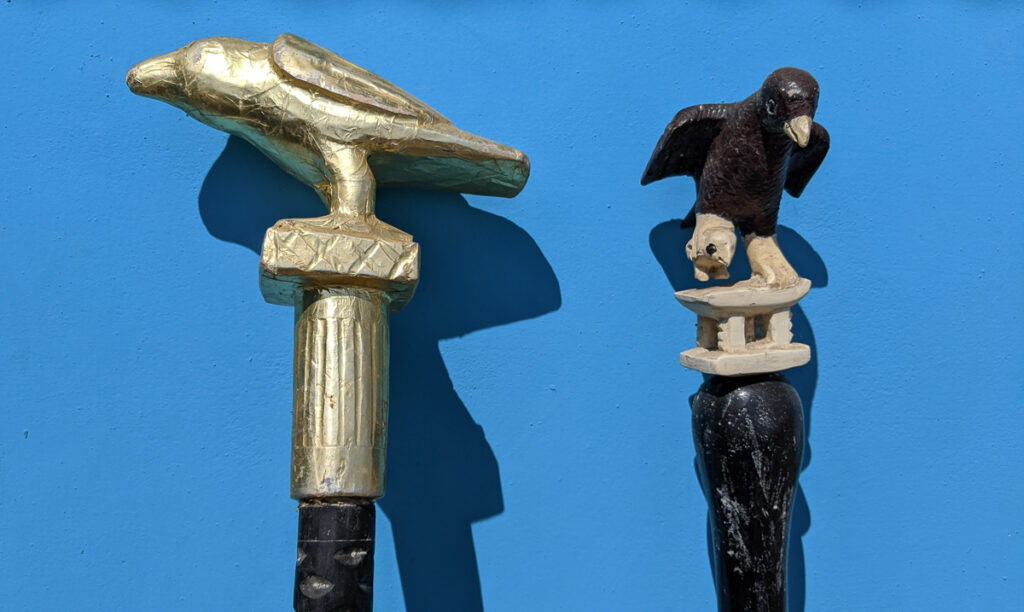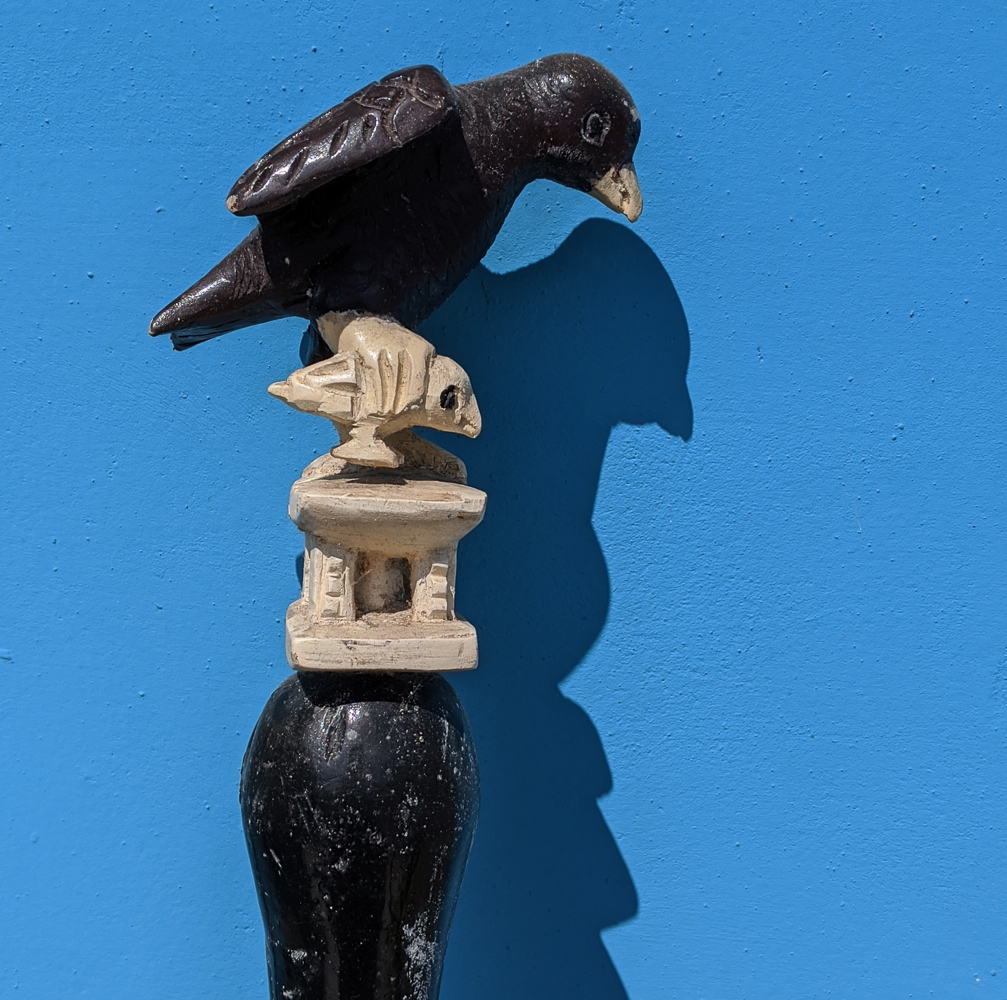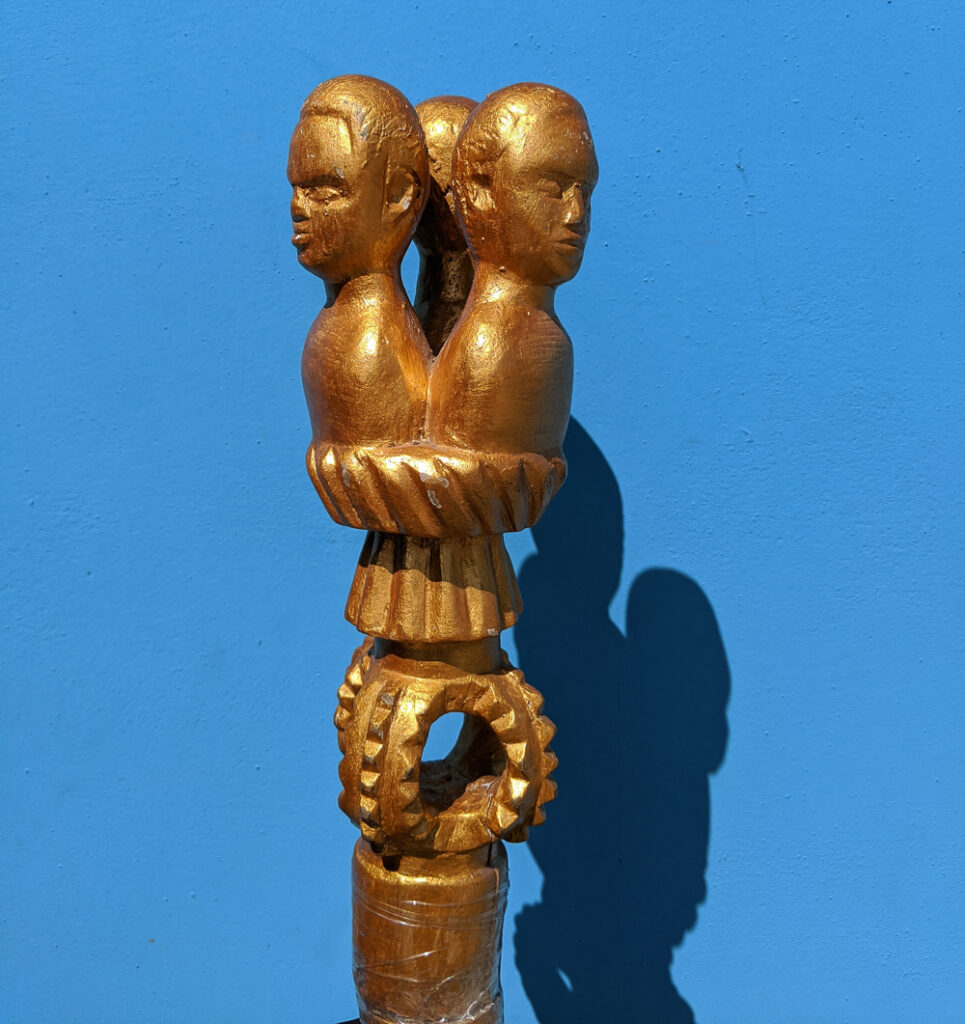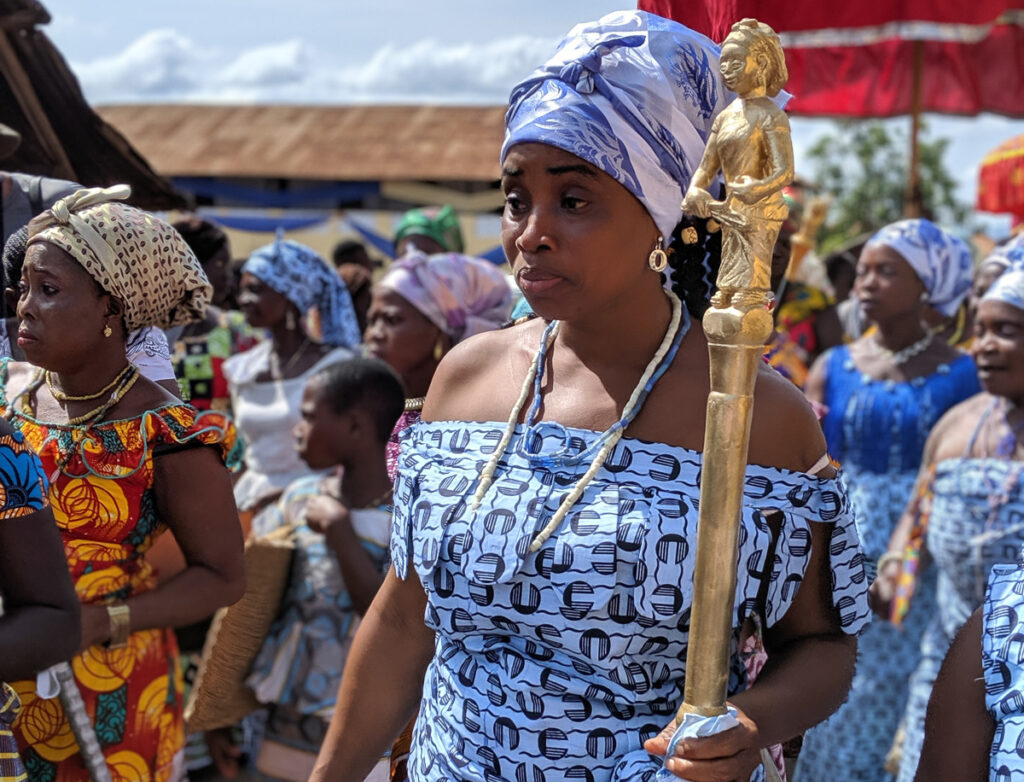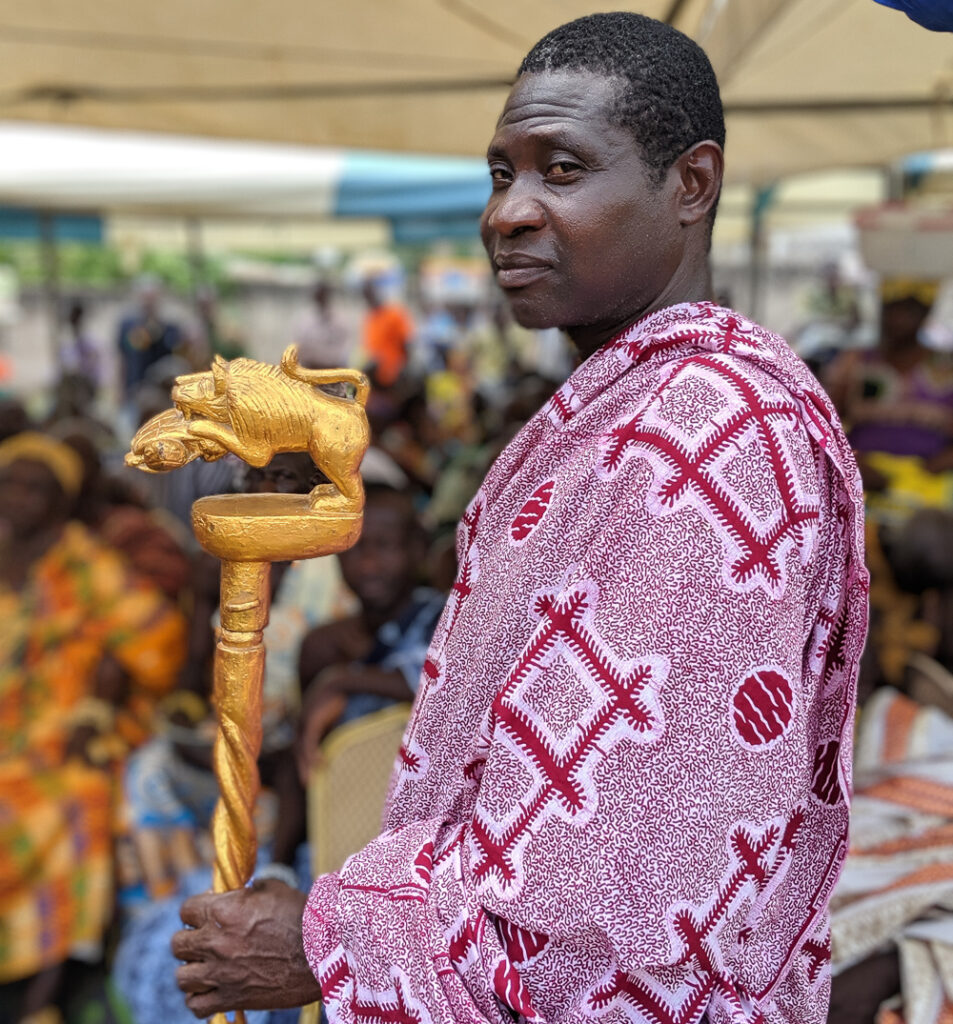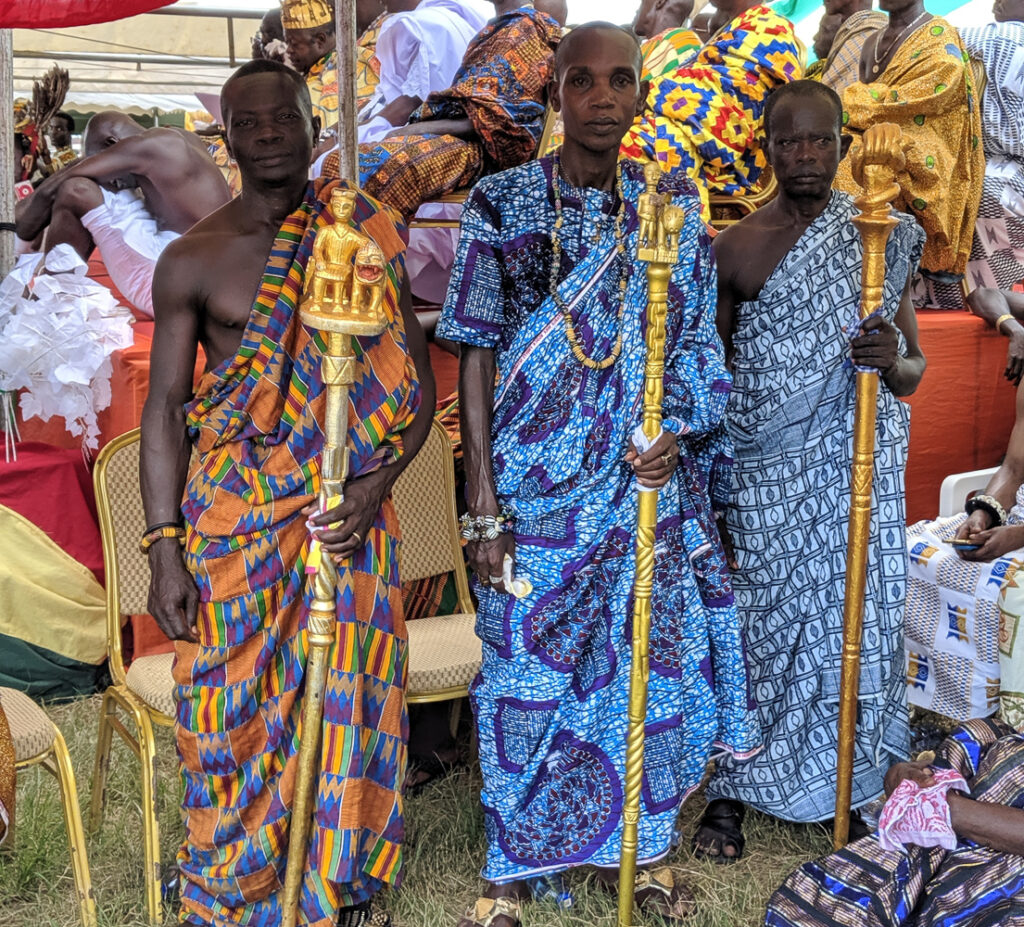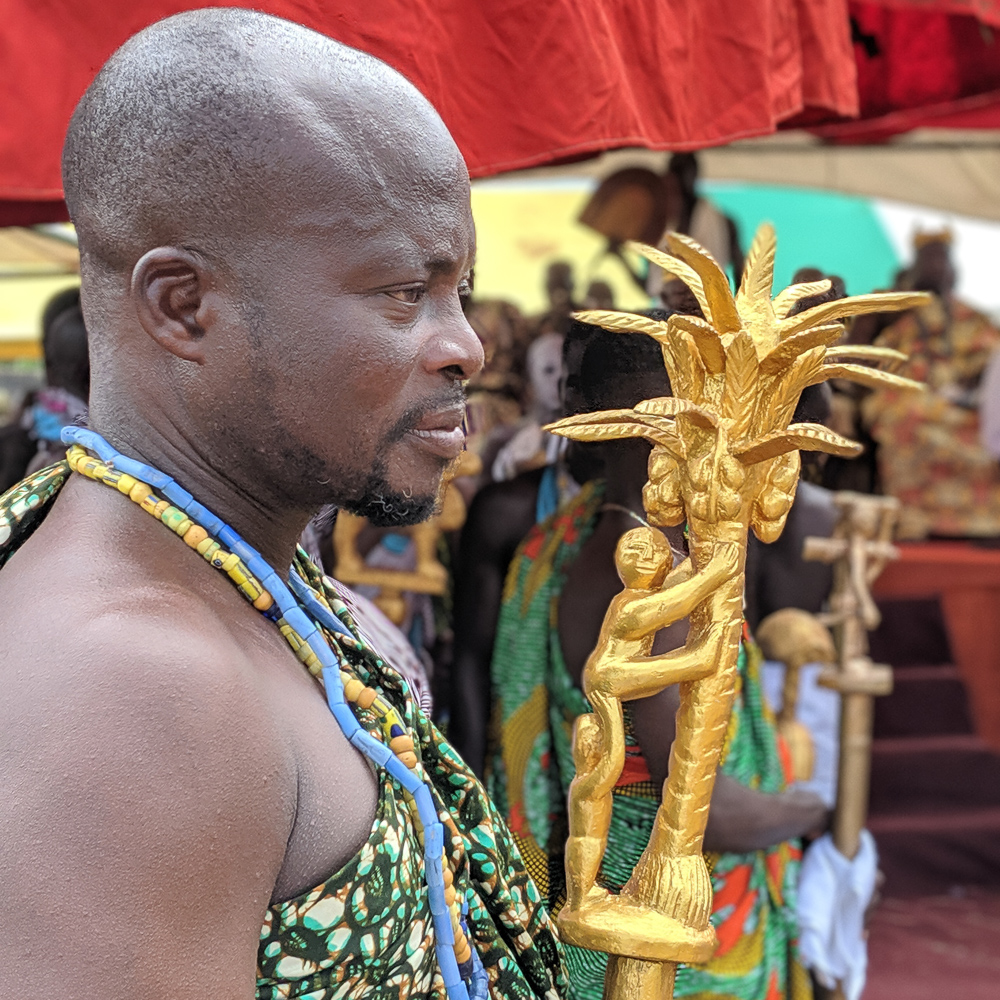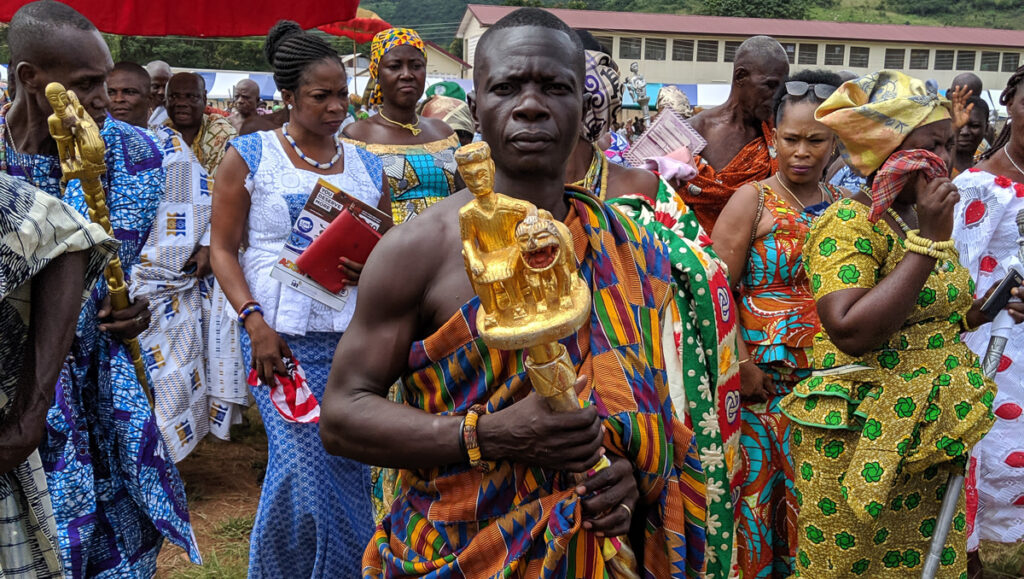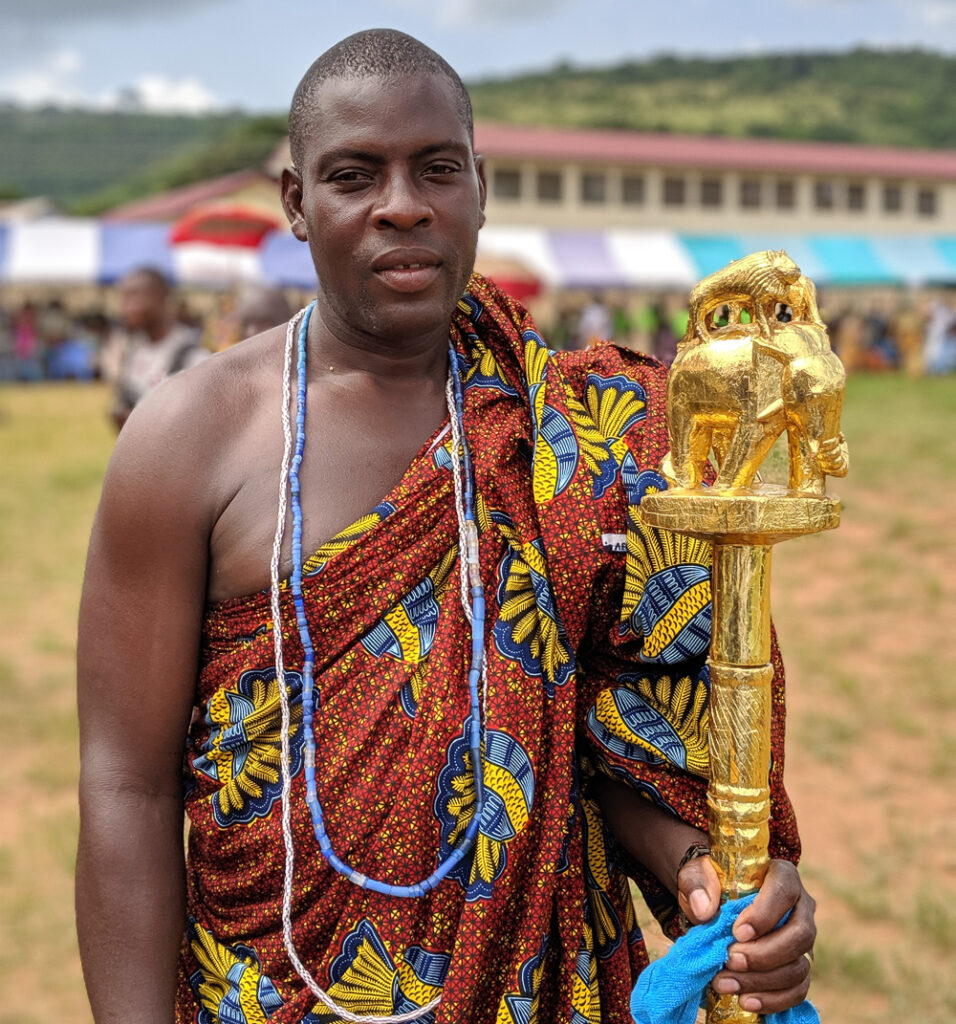
Manya Krobo Durbar, Millet Festival 2019, Linguists and village Chiefs listening to Paramount Chief, Nene Konor address the Durbar, Ghana
In Ghana, Claire Dale commissions a ritual object for talking to Chiefs.
8.30am was the agreed time I was going to meet Michael Oppong in the wood carving section at the “Aburi Craft Village”, atop the lush, tropical hills in Aburi, directly north of Accra, Ghana’s capital, on the roadside, set just off to the right. It’s a well-organised collective with space for approximately 200 artisans who are predominantly woodcarvers. Created by Miller Opoku Ware and his peers somewhere around 1983, it solidified itself over the next 30 years, with the help of several local Christian and German expat benefactors, in addition to the odd government grant, and is now the one-stop-shop for Ghanaian woodcarvings, mainly expat souvenirs. However, it’s also a hub for locals to commission authentic ceremonial regalia used in the multitude of important local Festivals, *Durbars, and funerals celebrated in Ghana. Stools, thrones, palanquins and language sticks take centre stage in the administration of local village politics. Michael was carving an “Ankyianpoma – Language Stick”, for me.
My fascination with Language Sticks and “Okyeame – Linguists”, came about when I was lucky enough to attend a few regional Festivals and Durbars (an important district celebration involving surrounding Regional Paramount Chief, village Chiefs, Queen Mothers, their courtiers and villagers). One standout experience was a Durbar Day at the Manya Krobo Ngmayem Festival, 2019, otherwise known as the Millet Festival, where the all the regional Sub Chiefs, Chiefs (sometimes referred to as Kings), Queen Mothers (matriarchal authoritarian figures who can serve alongside an enstooled Chief/King, and are family relation, but not by marriage.) and the Paramount Chief (Regional/District Chief, of all area Chiefs and Sub Chiefs), namely Nene Salute II, Konor of Manya Krobo area were in attendance (“nene” is a monarch title given to enstooled Kings/Chief and Queen Mothers, which precedes their name, in order to signify their position/royalty). The Vice President of Ghana and his crew were also attending to do both government and regional (traditional) business, through the Paramount chief. It was also an opportunity to give thanks in a cultural way for the millet harvest each year. It was the perfect opportunity to witness the Linguists and their Language Sticks, play out their duties in spectacular fashion.
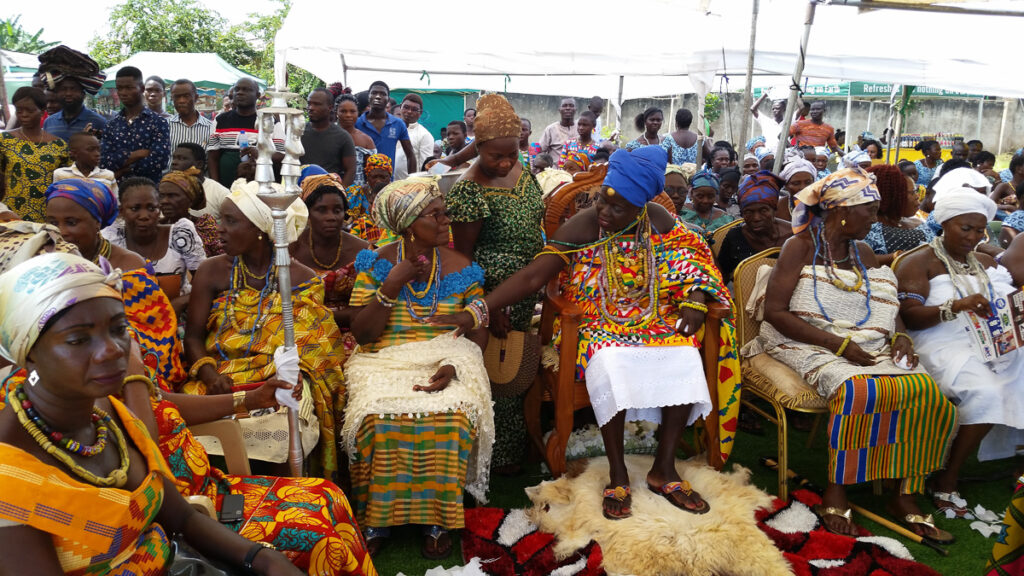
Manya Krobo Durbar, Millett Festival, 2019, A Village Queen Mother and her courtiers, Krobo, Ghana
Now, where there’s a Chief, there are courtiers to the said Chief. Drummers, Bell Ringers, Sword Bearers, sometimes known as the Executioners, Palanquin Bearers, Parasol Holders, Fan Holders, Soul Boys ( tasked with being a food and drink taster, to avoid any harm becoming the Chief he serves; his lineage is from the Chief’s sister or nominated female family members), chair and cushion carriers, family representatives, wives, and finally, the most fascinating of all, Linguists. Important chiefs can have several “Akyeame – Linguists” (plural), which makes for a spectacular showing at Durbars. Especially in the processions approaching and leaving the Durbar grounds. In some respects, the procession is a better vehicle for parading the King’s Courtiers, than the main event.
The “Okyeame – Linguists” are the keepers of the “Ankyianpoma – Language Sticks”. You are not permitted to speak directly to the Chief, at any time, unless given permission. Protocol dictates that you must first approach the Linguist, who is holding the “Language stick”, with your request, speak your wishes to the “Okyeame”, who will then transcribe your business back and forth between you and the Chief and/or Queen Mother, until all matters are resolved, or until you are dismissed. A linguist is needed to make sure there are no misunderstandings, mistakes with local customs, or misinterpretations during the consult. This protects both the Chief (Nene) and the loyal subject, along with any variation on regional customs that accompany the interaction.
Durbars allow village royalty to display their courtiers in the best light possible, as they are a direct reflection on their reputation and that of the villages. Prestige and high esteem of Chiefdom are well woven into the Ghanaian culture, as they have always been a proud nation. Priding themselves on their physical strength under inhumanely punishing conditions of times gone past, mental fortitude also holds a place within the notion of being “proud”. Language sticks seem to embody that pride in successfully doing the Chief and his village “proud”.
After being swept away with the pride that the Ankyianpoma were able to evoke when paraded by their custodians, I set about trying to find these very special sticks and woodcarvers who made them. They seemed to possess a kind of magic that would solicit total respect and adherence to the local customs within which they inhabit.
Each one carved is imbued with pertinent meaning, used to directly identify and project a Village Chief’s or Queen Mother’s Family name, values, morals and day to day code of ethics, during public displays at important local ceremonies in the most succinct but grandest of ways.
- Aburi Palace Language Sticks, wood, acrylic paint, paper mache’ and gold paint_Ghana, 2019
- Unknown, Figural representation of a Common Blackbird representing a Family name, Wood, acrylic paint, approx. 5.2ft
- Unknown, Three heads are better than one, wood, gold acrylic paint, approx 5.2ft_Aburi Palace_Ghana, 2019
Originally, from the Akan culture, some of these sticks had solid gold finials, using the lost wax casting method, or were carved out of local sese’, onenya or mahogany wood and then covered with a thin gold shim. But these days they are almost exclusively carved and finished in wood, and then either gold or silver-leafed, papermache’d over wood, or directly spray painted with gold paint. Gold seems to be reserved for men, while silver is seen on women’s staffs. Wood is much more accessible now, and easier to work within all aspects. Most I’ve seen to date seem to be spray painted a metallic gold, or hand-painted with appropriate colour. Regardless of how they are finished, I find them as a form, utterly enchanting. They do command respect. Apart from being protocol markers, the sticks are able to stand alone as things of beauty.
Figural depictions of old Ghanaian proverbs are carved onto the top of a body length stick, telling the story of the Chief’s family name, through an old Ghanaian proverb of his choice. Most proverbs seen on the Ankyianpoma finials today are a combination of traditional proverbs and colonial iconography, morphed together over time. An example would be the symbolic nature of the Lion as a regal show of strength, pride and courage, have made their way into these pieces from colonist times, and are here to stay, whereas the “Ga” elephant and antelope motif (Ga-Adangbe people from Accra) remains unchanged, and speaks a similar truth in a slightly different way. An elephant always appears on the bottom as a show of strength and utmost reliability, with the wisdom and stealth of an antelope perched on the elephant’s back. It declares wisdom wins over physical power. It can also allude to the fact they both work well together. Variations on this theme are made with lions on an elephant’s back: strength and courage. Each village would use different iconography and proverbs depending on their livelihoods and ethnic divisions. Elmina, as a fishing village, just past Cape Coast, would use references to fishing, abundant fishing harvests, trustworthy boats, using marine iconography and the like, whereas an inland village may have reference to metaphors such as pineapples, wildlife and the more emotional notion of giving thanks or taking care of the environment.
The Lord Robert Penrose. What a lovely man. He is my absolute well of information. His shop, The Black Man’s Culture, occupied a prime position at the Craft Village, which is where I met him. He became an invaluable contact and source of authentic knowledge, totally investing in my cause, and going out of his way to help. He’d taken me to The Aburi Palace where I was granted permission to see a few well-loved “Ankyianpoma” still in use. Old staffs are kept in village palaces and re-used until new chiefs, Queen Mothers, or Linguists are chosen. They are rarely thrown out, and I was able to see a few. One such example is a popular choice around Accra. Three heads, backed up together, with faces looking outward. Its message is simple.
“Three heads are better than one”
It doesn’t need any translation or cross-cultural referencing. In Accra, this would mean, don’t be afraid to approach the Chief or family elder with any burdens you are carrying as they will ask their councillors for advice in trying to offer the help you need.
Once a proverb is decided upon, it’s either drawn out or written down and given to a carver specializing in staffs. Ankyianpoma are custom made pieces specifically for Chiefs or Queen Mothers who require the Linguist to represent their family lineage and values. Gender is not assigned to the pieces. The message is more important than any perceived gender bias and proverbs are told in both masculine and feminine. Most proverbs use metaphorical images derived directly from village life, farming and family histories, making them instantly recognisable when paraded in public. This may account for the lack of bias, due to the labour split in day to day living. One such depiction of a great Ghanaian proverb is:
Proverb: “A good climber deserves a push”
Translation: “Help a man who is willing to help himself”.
- Akyeame (Linguists) for Nene Konor , of Manya Krobo District, 2019, holding a hand carved, wooden, gold leafed Ankyianpoma (language stick)
- Manya Krobo Durbar, Millett Festival, 2019, Linguist on her way to the Durbar as part of the procession, Ghana
- Manya Krobo Durbar, Millet Festival 2019, Linguist and his Language stick with a Lion motif, Krobo, Ghana
- Manya Krobo Durbar, Millet Festival 2019, 3 Linguists and their Language Sticks, wood and gold leaf, Krobo, Ghana
- Akyeame (Linguists) for Nene Konor , of Manya Krobo District, 2019, holding a hand carved, wooden, gold leafed Ankyianpoma (language stick)
- Manya Krobo Durbar, Millet Festival 2019, Linguist and his Language stick, seated man and lion, Wood and Gold Leaf, Krobo, Ghana
- Manya Krobo Durbar, Millet Festival 2019, Linguist and his Language stick with an Elephant and Lion motif, Wood and Gold Leaf, Krobo, Ghana
- Manya Krobo Durbar, Millett Festival, 2019, Linguist with his Language stick, Krobo, Ghana.
- Akyeame (Linguists) for Nene Konor, of Manya Krobo District, 2019, holding a hand carved, wooden, gold leafed Ankyianpoma (language stick). Approx 5.2ft high
Having met with Lord Robert over the course of several weeks, and been on several stick chasing excursions, I was even more excited to see as many as I could to build up a repertoire of understanding. He told me that it was going to be hard because they are all exclusively kept each in individual village “Palaces” (the official home of Village Chiefs official home where he lives with his whole family and conducts village business) and only used for celebratory occasions. Although I did see some, I feared I was in for a “hen’s teeth” kind of search. I’d also wanted to sit in on an order being carved, to record the stick being brought to life. It became apparent the only way to see one being made was to order one myself. So be it. Mine would use bird motifs to show:
“Only room for one in the house”.
It alludes to the fact that there is only room for one Chief in the village. A weaver bird has made a nest just big enough for itself, but there is another bird wanting to get in. This is a warning to others that the sitting Chief will not put up with any nonsense to do with challenges to his enstoolment as leader of the village.
Once I’d decided upon my proverb, we walked down to the back of the Craft Village Shops, which opened up into a small clearing in the bush. The heart of the operation was nothing more than a few well worn, corrugated tin sheds, partially reclaimed by the jungle. Woodcarvers were busily filling souvenir orders. Chatting and laughing heartily. Wood chips flying everywhere. Chickens happily clucking about. Cats nestled in wood chips sleeping. All was one.
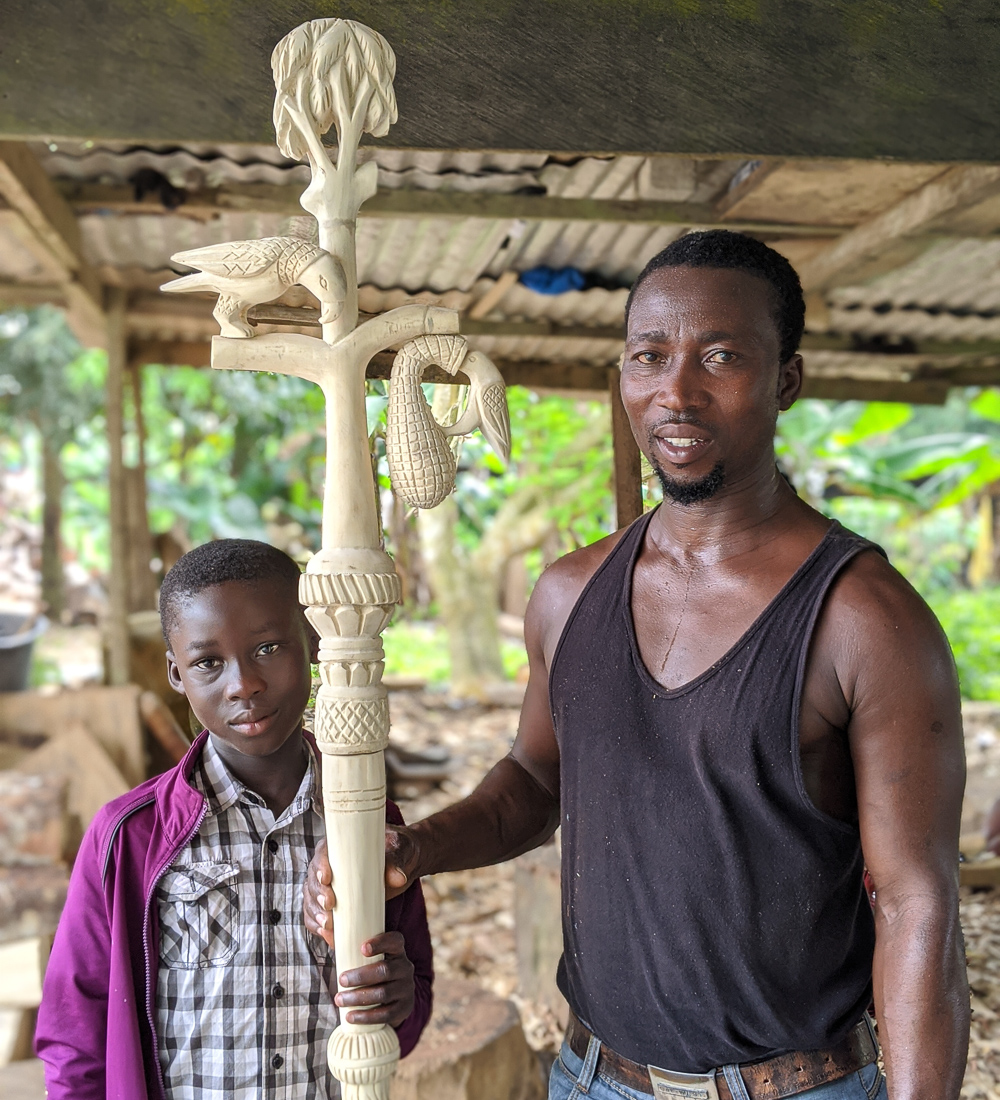
Michael Oppong and his Son, 2019, Sese’ Wood Language Stick, Aburi Craft Village, Aburi, Ghana
My carver, Michael Oppong had pride of place in the middle of a very rustic, thinly posted, corrugated roofed pavilion, held up with a wing and a prayer. He’s the cousin of Miller Opoku Ware, one of the founders of Aburi Craft Village, which afforded him the prime position, right in the middle of the springy sawdust pit several carvers occupied. Miller had taught Michael his craft. Stepping into the pit seemed like I was taking a liberty of sorts. Hallowed ground. Simply being a white woman stepping into the heavily male-dominated environment was somewhat trepidatious. I seemed to be a novelty. Lots of cackling and “in” jokes, about me being his slave driver flew about the place, as I approached him with my image and asked if it was possible to watch him carve, and ask questions as he worked.
“Yes”, was the answer.
Well, then. I now had to sort out the price, and terms of the job. A deposit was made.
The next morning Michael’s carving tools were laid out to the left. Wood chisels here in Accra, are made by the “Spring Doctor”, a chirpy local blacksmith only known as Grand Paa. His workshop down the road uses car and lorry springs, neatly forged into sets of tools, ready for sharpening when purchased. Michael’s set was razor-sharp. Mallets favoured function over form and are made on-site, in a no-fuss fashion. Looking more like clubs than the handled mallets we would normally envisage.
Dressed in an old pair of jeans as overalls on top of his shorts, he promptly began work. Kept company by his “friends”, a clowder of cats he is very fond of. In particular, a pregnant one he’d made room for, at the back of his log seat. Once it all began, I wasn’t prepared for the immediacy of the woodcarving process. Everything is done raw, straight from nature. No prefab or already dressed stock pieces here. Beyond Michael’s rudimentary shed, were two gents with chainsaws, and a massive heap of trees just delivered. They had set about hand shaping stock to size for the carvers to use. To the right of the shed was a small stockpile of recently felled trees, ready for working with. Lengths of 4-6ft, and 1-2ft wide. Still barked, and not yet dry. Michael rummages a few seconds and finds a suitable piece to make my staff out of. With no fuss, and in the blink of an eye, he’s split the section into two pieces which will be top and bottom of my stick. He sets himself down on his tree stump and sets about cutting smaller sections for the finial pieces. Two birds, a nest, tree branches and some leaves for the tree. Wooden blocks are judged by eye for scale and marked out with a blunt pencil for shape. Michael set about carving and didn’t stop for at least 4 hours. Lunch. His beloved cats got fed first, on kenke’ (fermented ground white corn or maize) and fish. Michael ate what remained.
After lunch, he roughed out the basic shapes mainly with his adze. Again, a locally made axe, ergonomically designed and effective in its ‘leverage of force’ properties, making light work of the job at hand.
I sat and watched Michael with nothing but admiration. Obviously talented, he forged through a good six hours of solid work with very little respite. His arms rose to strike at a steady pace every few seconds. This was no easy feat considering the dense humidity and heat that permeates the air in Ghana. Physical activity is extremely hard on the body in tropical climates, requiring more fortitude than normal. I suppose the constant background chatter made up of clacking chisels on wood, chainsaws, carvers busying themselves with gossip as well as work, radio playing, chickens crowing, cats meowing, created an atmosphere quite easy to lull into. Meditative. By the end of the first day, he’d roughed out the finial elements, shaped them, and carved the detail on. That was enough. They had to rest in the sun a while to dry a little. The day was done.
Day two, saw the lower half of the staff take shape. Usually, they’re made in as a three-piece assembly for travel. Mine was in two pieces. Watching the stick section being carved highlighted the fact that it’s necessary to use the whole body, and every appendage available, to help hold the wood in position. I was wincing at how close the tools came to fingers and legs. The same process was followed as the day before, with roughing out the shape for the base of the stick and fine-tuning with the adze. Planing the wood by hand was then done before decorative details were deftly added using a variety of specialist tools. His honed tools chiselled through the wood like butter, fine-tuning and embellishing each element as if modelling it with clay. Once the two halves were more or less finished, sanding occurs to smooth any major lumps out, and a pressure fit plug created to connect the two halves is added. All pieces are put into the sun to dry out before they are painted black, then gold.
Watching Michael work was an absolute treat. Although he would not call himself an artist, he told me “I can carve you anything you want”. Totally confident in his abilities. A job well done, comes before ego. Before enjoyment, and most definitely before poetic license. For Michael there’s no point romanticizing the Arts and Crafts. He needs to make a living, and that’s the top priority. While I’m guilty of my fallback position, appreciating them for aesthetic reasons, Michael uses his skills for the creation of significant cultural objects full of meaning, and for that he is proud. Used often, they are important pieces in the context of Ghanaian cultural heritage. I salute him and his contemporaries.
Having just scratched the surface, I look forward to discovering more about the world of Ankyianpoma and their Akyeame. In time, I fear the introduction of plastic or lighter metals such as aluminium, may change the direction of these regal artifacts, so I’m grateful I’ve been able to experience them from start to finish, in some small way before that happens.
Author
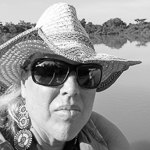 I’m a retired designer and teacher now living in Perth Western Australia. Having spent the last 3 years in Accra, Ghana, I was instinctively drawn towards the traditional arts and crafts which are the beating heart and soul of their cultural identity. For most indigenous peoples, life IS art. Many of these art forms go undocumented because they seem so “everyday”. It prompted me to consider a change in career path, as an arts photojournalist/journalist, allowing me to investigate and record first-hand, the treasures people make with the voice of their elder’s rich traditions guiding their hands.
I’m a retired designer and teacher now living in Perth Western Australia. Having spent the last 3 years in Accra, Ghana, I was instinctively drawn towards the traditional arts and crafts which are the beating heart and soul of their cultural identity. For most indigenous peoples, life IS art. Many of these art forms go undocumented because they seem so “everyday”. It prompted me to consider a change in career path, as an arts photojournalist/journalist, allowing me to investigate and record first-hand, the treasures people make with the voice of their elder’s rich traditions guiding their hands.

